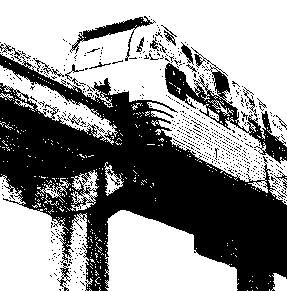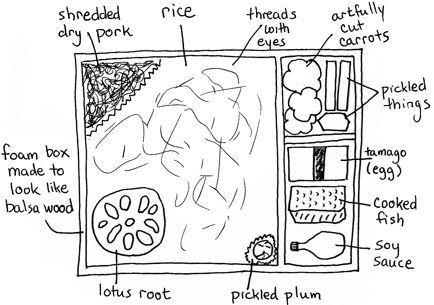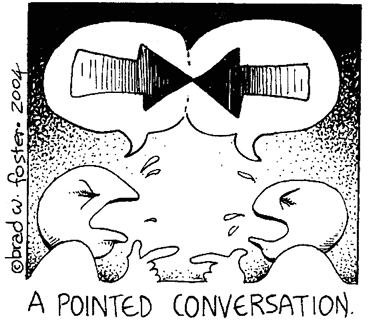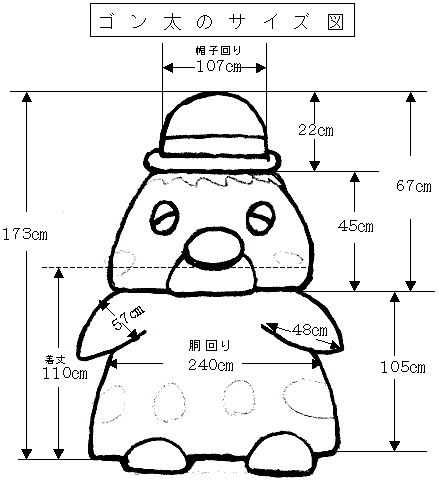


I went to Guanajuato, Mexico this June. I'd noticed an entry in the Portland Community College catalog: "Study Spanish each morning and live with a Mexican family, sharing meals, conversation and culture. Classes start every Monday—choose your own dates!"
And only $600 plus airfare! For a language geek with time on her hands (David would be at a two-week-long writing workshop), this sounded perfect! And I'd never been to Mexico. Nor to any other Spanish-speaking country—this would be my first real encounter with it since Spanish 101, senior year.
Have you ever been to Virginia City, Nevada? It's on a hillside so steep that back doors tend to be on the third floor. Well, Guanajuato makes Virginia City look flat and unimaginative. (They have a silver mining heritage in common. Depending on who's telling it, Guanajuato at one point produced one- to two-thirds of the world's supply of silver.) It's like a coral reef, downtown a series of ravines, stairways serving as streets, buildings barnacled one above the other. Our house had a gate at street level, then 15 steps down to the front door. It kept going down from there.
The house situation was a little strange. Not so much a home-stay as a boarding house for language students, five or six of us while I was there. We ate breakfast and lunch together, with Señora present to encourage (and correct) Spanish conversation. We shared neither meals nor living space with the family, apart from the kitchen. There was a television under one flight of stairs which we could use, if the daughter hadn't hidden the remote.
But it was clean, the beds were comfortable, the plumbing worked, and either Señora or the help could cook like a dream, so what the hell. Once lunch was over, day after day I headed into town and tromped around for hours, exploring.
They told us at the school "Don't eat anything outside your host home or the school for a week or two, until your gut adjusts. If you get sick you'll miss class, and that's what you're here for." Hah! I've only got two weeks—and I'm here for the food as much as for study! It really was wonderfully liberating to be taking classes purely for my own interest. I had a few hours of grammar (use of the subjunctive, when to use which past tense, etc.) and some conversation classes, each with just 2-5 students.
Meeting the wide variety of people taking classes at Academia Falcon was an unexpected perk. Many were teachers going for CEUs, or needing Spanish skills to talk to their students. There were doctors, high school students, kids there with their parents, two Japanese women living in Kentucky, and my neighbor at La Casa Bizarre, a forthright recovering alcoholic from Texas money whom I never would have met in the normal course of events. We got on great. And not just because her boyfriend sent two seasons of Battlestar Galactica DVDs with her.
The other boarders were college juniors from Ohio. One asked me, over tacos in a dive downtown one night, "So when did you last study Spanish?"
"Er, 1982."
Her eyes got big. "OMG! I didn't even exist then!!"
"Yes, sweetie," I said, "I'm keenly aware of that."
But actually we too seemed more like peers than I would  have expected. I didn't go to salsa classes with them at the bars—left that to Texas Lisa—but we got on fine. As long as nobody took Janna's chocolate donut in the morning.
have expected. I didn't go to salsa classes with them at the bars—left that to Texas Lisa—but we got on fine. As long as nobody took Janna's chocolate donut in the morning.
Señora owned a couple of panaderías, so there was always a large tray of baked goods at breakfast: donuts, croissants, cookies, French rolls, sweet breads. She'd also put out milk, juice, sliced watermelon, and yogurt, and fix scrambled eggs.
Classes paused at noon, and the school had a small lunch counter. I got in the habit of having a cheese quesadilla with avocado—choice of wheat or corn tortilla—80¢. Their burritos were only slightly more substantial, a far cry from the typical norteamericano gut-bomb. Lots of people drank yogurt, or had hot chocolate that the cafeteria ladies mixed vigorously with wooden pestles.
We only needed a bite to tide us over. The main meal of the day was at 3pm. At our house, that invariably started with soup: cream of chayote, maybe, or a rich pot-roast-flavored broth with rotini and a few zucchini slices. Pozole, a hominy soup, came with a dozen optional fiddly bits to add, like eating Mexican pho! That was the whole meal that day. Otherwise there was seasoned rice, steamed veggies, and an entrée: chili relleno, or gorditas, or salpicon, or chicken in a pumpkin-seed mole…. OK, hungry now! Restaurants always brought tortillas, but Señora usually put out French bread and a plate of sliced avocado (a lovely substitute for butter).
Dessert? Oreos. Go figure.
Easy enough to buy a donut from a street vendor or a panadería. I found a candy shop with cubes of strawberry jelly that tasted like congealed summer. And on hot afternoons, I became very fond of the mango micheladas at the As de Copas bar just past the Mercado Hidalgo. A classic michelada is not unlike a bloody mary with beer instead of vodka; this version was cold beer, mango juice, a dash of hot sauce, and some chili-sugar-salt on the rim of the glass. Seriously refreshing.
(Also appreciated that the bartender explained how to find the bus home—seems central Guanajuato's eastbound traffic runs in tunnels! When I'd been told to catch the bus "debajo del Jardín" I thought that meant at the bottom of the Garden, not beneath it!)
Sometimes I had a carnitas torta at the market, choosing the stall on the basis of how crowded it was. They would pull a hunk of pork out of the display case and chop it up for your sandwich on an inches-thick white plastic cutting board, dished in the center like a medieval stairstep. These same vendors also did a brisk takeaway business in tabloid-sized sheets of pork rind. I don't know if this was an ingredient, or eaten as is. There was certainly an appetite for crunchy fried stuff: I repeatedly saw people carrying home Costco-sized bags of what looked like baby carrots, but were in fact giant cheese puffs.
Apart from all the fascinating things I saw (and ate), there was the invaluable experience of being surrounded by Mexicans in Mexico. Pathetic as it is to admit this, it was like a child learning that other people have inner lives of their own; or a guy figuring out that lesbians aren't that way because they "hate men"…. My experience of Mexicans had always been in relation to the United States: they were Mexican-Americans, or they were immigrants to America, or making treaties with America…. But Mexico isn't about us. It just is.
— KY
A man and a woman emerge from a jetway into a teeming modern airport. They are thirteen years older than the last time we saw them. They wear short-sleeved shirts and blue jeans, and pull heavy suitcases on wheels. A banner overhead reads "Welcome to Macintosh."
"Well, Mama, we made it. Welcome home."
"Home, Papa? I barely recognize the place. It's so... so big! So fast! So colorful!"
"Well... there have been a few changes, I'll admit. But it's all to the good. Did you really expect everything to be in black and white, after all these years?"
"No, Papa. I didn't really know what to expect. But this... it's more like where we just came from than what I remember."
"That, too, is all to the good." He pats his bulging suitcase. "It means we can bring every bit of our new data with us."
"Except for the FrameMaker files. And your Outlook archives."
"Well. Yes. But still. Look up there!"
"Oh! The menu bar!"
"Up at the very top, where God intended. And look... the Apple menu!"
"But where are the desk accessories?"
"Hm." He frowns. "Perhaps they are on the Dashboard." He consults a copy of The Missing Manual, runs a hand across his now-bald pate. "I never thought I would need a guidebook to the Old Country."
They shoulder their way through the crowd, occasionally waving to a familiar face.
"Look, Papa! There's another one of your writer friends! Who'd ever have thought so many people would want to leave the Land of Opportunity for the Old Country? They can't all have made their fortune and come home, like we did."
"Some of them never left."
"But look at that immigration line! So many of these people are coming here for the first time."
"They've come for the same reasons we're returning. The bugs. The viruses. The new regime." He shudders. "So much is changing now... you might as well move to the Old Country. It's no more traumatic."
"There's a new regime here, too, Papa."
"Yes, but the changeover was years ago. Look how happy everyone is now!"
"I'm glad we didn't have to live through that trauma."
They pass easily through Customs, their baggage being shuttled automatically to their destination. Most of the crowd takes the freeway into town, but Papa spots a monorail. It is an artifact from the 1960s, but still sleek and efficient.
 "Look, Mama, a command line!" They enter the monorail, the doors hissing shut behind them. "A command line in the Old Country. Can you believe it? I remember how everyone here used to revile them." He spreads out on the seat with a satisfied "aah." "People think these things are old-fashioned, but there's really nothing like them for rapid transit."
"Look, Mama, a command line!" They enter the monorail, the doors hissing shut behind them. "A command line in the Old Country. Can you believe it? I remember how everyone here used to revile them." He spreads out on the seat with a satisfied "aah." "People think these things are old-fashioned, but there's really nothing like them for rapid transit."
"Whatever you say, dear." She pats his hand.
The monorail whisks them to the city center and their new home.
"Papa, it's so huge!" She dashes about, opening cupboards and cabinets. "But where is all our stuff? Nothing's where I expect it to be..."
"It's all here." He pats a door. "This is your stuff. Our shared stuff is over here. And my stuff is over there. Um, you'll have to ask me for permission if you want to see any of that."
She pouts. "It was easier when we just had one set of folders for the two of us."
"If you can't find anything, just ask. Spotlight, where are the recipes?"
"Here they are, sir." A long list of recipe files appears.
"Oh, my. A girl could get used to this." She takes a recipe and moves into the kitchen. It's full of slick and modernistic devices. "What is this, a laboratory?"
"It's the kitchen! Look, all the latest appliances! iPhoto! iTunes! iCal! iWork!" He calls up iWork, a dazzling confection of colorful polished surfaces. "You'll never have to deal with Microsoft Word again!" iWork coughs and spits out a cloud of blue smoke.
She glares at him. "Spotlight, where is Microsoft Word?"
"Here it is, ma'am."
"Thank you." She takes the clunky old appliance and places it on the countertop. "This will do just fine."
He spreads his hands. "As you wish, Mama."
Weeks pass.
"Papa! Paapaaa!"
He comes running into the kitchen. "What is it, Mama?"
"I was just trying to scan a photograph, and now... look!" Pixels are scattered everywhere.
"Don't cry, liebchen. It's just... um... er... you need to... er?... wait, I'll..."
"It's as messed up as my iPod! And everything was supposed to be so easy here! I want to go home!"
He takes her in his arms. "Hush, hush, liebchen. We are home."
"Oh, but Papa..." She dries her eyes on her sleeve. "We've been away so long. I... I feel like I don't fit in anywhere any more."
"I know, Mama. I feel that way myself, sometimes. But then I look at the news from back ho... from the Land of Opportunity. The viruses are worse than ever, and the new regime is becoming more and more inescapable. Here we have safety and stability."
"I suppose." She sniffles.
"Liebchen... there's something I've been meaning to get you for a while. Wait here." He hurries away, comes back with a small package. "I hope it's the right color."
She opens the package, looks at him askance. "A phone?"
"Not just any phone... an iPhone! It's the latest. 3G. It knows where it is."
"I'm not sure that's a good thing. I've read Little Brother."
"But you can check your email... play your music... and the interface for voice mail is just brilliant. It will even ring when someone calls you. Unlike your current phone."
"Ringing is good." She turns the device over in her hands, still a bit dubious. "It is rather cute."
"You'll love it... I hope."
"Thank you... I think." She kisses him.
They embrace.
— DDL
Bento 20 was produced on a 20" Apple iMac with a 2.8-GHz Intel processor, 2 GB of RAM, 500 GB of disk, and a Brother HL-5250DN laser printer. Software used included OS X 10.4 Tiger, Microsoft Word, Pages for layout, and ClickBook for imposition. We are once again a PC-free household.
"Thank you for your lino, but we regret it does not meet our needs at this time."
This was David's regretful observation as we watched the annual gay square dance convention (held this year in Cleveland, which indeed does not have much going for it besides the Rock & Roll Hall of Fame; but if you do go, look up: the old buildings downtown have beautiful architectural detailing) zip past.
It's the same for Worldcon or any of our other fannish gatherings.
The first evening is one of recognition and reunion. Greetings are heartfelt but often brief: hey, there's the whole long weekend ahead for catching up! Friday passes in a blur, and by Saturday we have the hang of the hotel layout and the local humidity. Then it's Sunday, and people are found on the sidelines in increasing numbers, perhaps sitting in quiet puppy-piles, too pooped to Promenade, staring inwardly at the prospect of it all being over for another year.
I was in an odd "space" this year in Cleveland. I simply wasn't in the mood for noisy rooms & constant motion much of the time. Problematic, at a square dance convention! Next year I'll try to remember to bring a jigsaw puzzle, and hope for the right kind of table outside the dance halls—try to provide a nucleation point for conversation to crystallize around, the way a grand piano leads to show tunes.
Because even though I didn't always want to dance, I wanted to be there. It felt so very good to look around and know myself surrounded by My Tribe.
Which leads to thoughts that surely there are good people in Portland too, and perhaps I don't have to get on an airplane to hang out with friends?
But somehow at home, the days fill with appointments and trips to the gym, with cleaning out my spam trap and doing the dishes. Voom. If we try to connect with someone, it's not uncommon to find that the next mutually compatible date is weeks away.
Ah, I miss the dorms, where sociability didn't require effort, and mundane tasks like folding laundry could be done with someone companionably hanging out and chatting. It was so easy: just open your room door! (In case of emergency, make popcorn.) I don't think I'd get many takers if I got on the phone and said "Hey, wanna come over while I oil the kitchen counters?"
Discuss, please: what do you do to try to maintain depth in relationships with friends? Local or distant, either one.
— KY
"Don't leave the bar! The lobby will get you!"
The magic system in Jack Vance's The Dying Earth works like this: through long and diligent study, the magician crams the syllables of a spell into his mind. When these syllables are uttered, the spell takes its effect and then vanishes completely; to be used again, it must be memorized again. This is the basis of the magic system in original D&D.
It's also the way Japanese worked for me.
Kate started dabbling in Japanese years ago, when it became clear that we'd very likely be going there some day for either the Worldcon or for the gay square dance convention (both conventions have a small but dedicated Japanese contingent). She really began studying seriously when Nippon 2007 won its bid. I knew that I should do the same, but there was the day job and the writing and ooh look, LiveJournal.
Finally, with the Worldcon just weeks away, we went to Berlitz. It was expensive, but exactly what I needed. Lessons twice a week, to force me to study. And our "small group class" turned out to consist of just the two of us, so we were able to tailor the lessons to exactly what we needed. Thirty different words for family members? Who cares? Let's drill on how to ask for train tickets!
Sometimes it was frustrating. I found the grammar hideously unintuitive, and I couldn't keep the words straight because, in Japanese, every syllable consists of a consonant followed by a vowel and every syllable has equal stress. This makes all the words sound more or less the same. I could never remember whether domo was "thanks" and dozo "please" or vice versa, or keep the towns Kanazawa and Kamakura straight.
I'm a geek. I found a computer program called Studycard Studio that let me make up my own flash cards and I drilled constantly at home, at work, and on my PDA. Slowly the syllables forced themselves into my brain.
Another thing I drilled hard on was the writing system, especially the kana. This turned out to be one of the best decisions I made. Japanese has three different alphabets, you see: kanji, where each character is a word; hiragana, where each character is a syllable, and katakana, representing the same syllables as hiragana with an entirely separate (but related) alphabet. Katakana, or kana for short, are used much like our italics: for emphasis, for onomatopoeia, and for words imported from foreign languages.
That, as it turns out, was the key.
When we got to Japan I found that, thanks to Millard Fillmore and Commodore Perry, the language was crowded with useful English loan-words (albeit with the unique Japanese take on their pronunciation: depaato for department store, hambaagaa for hamburger, aisu kohi for iced coffee, etc.—you have to kind of de-tune your ear to understand them). And in writing, these loan-words were all in kana. If I spotted a sign, or part of a sign, in kana, all I had to do was sound it out (painfully, letter by letter) and I'd have a shot at understanding it. ("Paa... kii... n... gu... Paakingu? Oh! Parking!")
I was really, really glad that we weren't visiting the alternate universe in which the Portuguese had remained the major Western influence on Japan.
To my surprise, hardly any other fans had learned Japanese even as much as I had. I was reminded of rich Brits in France in the early 20th century: some could manage a few words of bad French, some got by with pointing and waving, and only a few really studied it. My ability to read kana, however slowly, was like having X-ray vision. I could walk into a bakery with a bunch of fans, sound out the labels on the pastries, and tell them which ones were kuriimu banuzu (cream buns) and which were fisu to masurumu hottodoggo (fish and mushroom hot dog, swear to God).
Although the kana helped, it wasn't a panacea. Brushstroke fonts were often unreadable. We'd been told not to worry about Japanese numerals, but they were used for prices at both ritzy and rustic restaurants. People were really impressed that we could read a cloth banner from the wrong side (upside down and backwards), but you see, reading rightside up and forwards was just as slow! And not all of those kana loan-words were borrowed from English. Ramen, for example, is written in kana because it's originally Chinese! And then there was the kurokku madamu, which we finally puzzled out was croque madame. (Not that the French would have recognized it as such; it was a waffle!) You just have to laugh.
Sometimes the Japanese tried to be helpful by writing things in romaji (Western letters) for tourists. Unfortunately, if your guidebook has the train station names in romaji and the train system diagram on the wall has them in kanji you're pretty well screwed. We were able to make some progress using Chinese Menu Algebra (see Bento 11): "Well, the big station where the red and yellow lines cross must be Nihonbashi, we're looking for  Akebonobashi, so both station names end with that bit with the squiggle..." It also helped that the Japanese trains always, always, always departed and arrived precisely on time. If it's 14:34 it must be Minatomirai.
Akebonobashi, so both station names end with that bit with the squiggle..." It also helped that the Japanese trains always, always, always departed and arrived precisely on time. If it's 14:34 it must be Minatomirai.
My spoken Japanese was not nearly enough, but it was much, much better than nothing. We were able to walk into a restaurant specializing in barbecued eel—one of my favorite kinds of sushi back home—and respond to the proprietor's dubious "unagi desu..." ("it's eel, you know...") with "hai, unagi desu" ("yes, we know it's eel"). It was delicious. And when we stumbled into a tiny working-class bar serving oden (boiled stuff) where the menu was all in kanji, we had enough Japanese to say "zenbu daijobu desu" ("anything is okay") and enough culinary daring to mean it. The food was unspec-tacular but we wound up having something resembling a conversation with the gals behind the bar, whom I nicknamed Flo and Dot.
We were in Japan for three weeks. After a while it got to the point that I could actually read a few kana words (notably aisu kohi) as words rather than having to sound them out, and even recognize common kanji like Men/Women and Enter/Exit. But within a week after we got back, I found that postcards and photographs with text in kana had become incomprehensible. A children's alphabet book I'd purchased to celebrate my command of kana is now nothing but alien squiggles. Even my own notes from the trip contain words in romaji that I no longer understand.
The spell, having been uttered, has vanished from my mind.
But it did its job, and I'm glad I had it when I needed it.
— DDL
Our overall itinerary: a day or two in Narita town while we get our bearings, then to Yokohama for the Worldcon. Afterwards, 2 nights each in Matsumoto (castle town), Takayama (quaint old streets), and Kanazawa. Then a week in Tokyo. These were all within about 100 miles of Tokyo. We got around by train or intercity bus. There was also one night in a very traditional luxury inn in a small town near Takayama. We ended up skipping Kanazawa entirely, tired of shifting.
We simplified our trips by using takkyubin, a hotel-to-hotel luggage service. Our big bags cost maybe $15 to send ahead. David really bit his nails the first time we left our worldly goods in the care of the Black Cat Carrying Kitten by Scruff of Neck Courier  Service, but I'd read about the ubiquity and reliability of the system. As long as you could do without for one night, it was fantastic!
Service, but I'd read about the ubiquity and reliability of the system. As long as you could do without for one night, it was fantastic!
I think it makes the people we're dealing with slightly more comfortable when we can throw in a few nuggets of Nihongo—"Arimasen, hai" ("isn't there, gotcha") when the museum clerk tells us that Gallery 3 is closed for renovation, "totemo atsui, hai" ("very hot, yes") when we're being warned about the extremely fresh-cooked octopus balls.
We had Japanese-style rooms three times. I came to love the grassy scent of the tatami mats, and I found sleeping on the floor, padded by a firm futon, to be quite comfortable. The hard part was conducting all business at ankle level: rummaging in suitcases, repacking, sorting through postcards, whatever. I longed for a few horizontal surfaces at waist height.
At the Matsumoto Museum of Art, one gallery of paintings (mountainscapes by a particular artist, and his easel and palette in the corner) was paneled in sugi, Japanese sweet cedar. That was lovely! I've never encountered an art museum using scent before. A world away from those god-awful ambient scent cannons at the Radisson Hotel in Minneapolis.
The inn in Furakawa was a brief walk from the train station through mild drizzle. We had just started to decipher which building was ours when 2 men in yukata bustled up bearing oiled paper umbrellas. They relieved us of our baggage (just overnight bags, we sent the rest ahead to Takayama) and our luxury experience had begun.
 They gave us frothy green tea and some kind of dark brown jelly (2 lumps each, eaten with tiny wooden fork, or maybe a toothpick with pretensions.) This was a combination welcoming ritual and stalling maneuver while they got our bags upstairs.
They gave us frothy green tea and some kind of dark brown jelly (2 lumps each, eaten with tiny wooden fork, or maybe a toothpick with pretensions.) This was a combination welcoming ritual and stalling maneuver while they got our bags upstairs.
We were led to our room, up hill and down dale, mostly tatami-lined though not the steep flight of gleaming, polished, repel-the-barbarian steps, interesting to navigate in stocking feet. We were each issued two folded yukata, one plain ("This for dinner only") and one with the family crest ("This for sleeping only"). We were briefly stymied when it came time to go bathe—what to wear, what to wear? David boldly called the front desk. "What you like," they said. OK then.
My tan dinner yukata turned out to be two-piece. I had no idea how best to use the ties and belt loops on the wrap skirt. Saw Japanese in the corridors later who clearly were faking it too.  Yay.
Yay.
The inn's hot-springs baths had parallel setups for men and women, swapping them overnight so everyone could experience the side with the cauldron, or the waterfall, or the better view. A changing room held shelves of baskets to put our things in, then you go into the wet room and wash, thoroughly, and then there were both indoor and outdoor pools.
The thing about Japanese baths is that no matter how many photos you see of subtle views and soothing steam, no matter how many words you read extolling their physical & spiritual wonderfulness, there's only so long you actually stay in the hot water. Or is that just a Western notion of mine, to go along with being surprised at an urn of cold sake there next to the outdoor pool?
As we left the next day, the doorman/shoe guy asked worriedly something about a kuruma (car). I held up one finger in what I hope is a universal "wait" gesture, lined up some words inside my head and pronounced triumphantly "Aruite ga suki desu." "We like the walking." Everyone happy.
The Ginza area of Tokyo looks like Park Avenue minus the hot dog carts.
We saw a hearse—not large, but very ornate, like a black cart with a king's gilt sarcophagus atop it. Nearby, men in black business suits with white armbands bustled about.
Down the street, in a café, a wedding reception was visible through the window. "They're eating cake and sushi," David said. I saw a man wearing yukata and geta carrying some long-necked stringed instrument in their direction.
We had beautiful sunny days and we had downpours. If I lived in Japan I'd collect umbrellas, deliberately, I mean, because there are so many attractive ones. There are umbrella stands outside or immediately inside every business and many homes. Some larger stores have cunning contraptions where you slide your umbrella down in, then pull towards you and hey presto! it has a plastic sheath, so as not to drip on the merchandise. (The amount of plastic we left in our wake on this trip was truly appalling.)
David reluctantly "harvested" an umbrella late one night from a rack at the Takayama post office—one spoke bent, building long closed, it was clearly abandoned and he was getting soaked. I tried to tell him it was all part of the Great Circle of Life but he wasn't buying it.
Museums tended to have umbrella lockers, racks where you hung the umbrella, closed a clasp about its shaft below the handle, and then took away a numbered key. Contents ranged from very nice to dollar-store models, and I'm sure many people walk away with keys in their pockets. I wonder how the museums deal with that—spare keys and periodic sweeps, I suppose. I like to think of the city's unclaimed umbrellas being given out free to the homeless.
—Whom we didn't see, except setting up very tidy cardboard cubicles in Shin-Yokohama station late one night, but I'm not fool enough to think that means they don't exist.
— KY
At a display in the entrance to New York's Adirondack Museum, I overheard a boy ask "Is this real water?" I fought an intense urge to pound my head on the nearest fake birch tree, but that just goes to illustrate that the kid had a point: we fill our museums with both reality and replica. And we can be casual about the difference: we tend to say "Lookitthat! There's a Viking ship!" or "It's a brontosaurus" for both kinds of display. After a day of dioramas, no wonder the kid doesn't know what's real any more.
(Note: not art museums. They're pretty fussy about such things, and we can assume everything in them is "authentic" unless vehemently designated otherwise. I guess I'm talking about museums for history, science, circuses, jute—"Museums about stuff," as it were.)
We use both kinds of objects because they serve different ends. The unreal may well be more informative: true Titanic artifacts tend towards anonymous corroded lump, while re-creations let us picture the deck chairs in use, the radio operator in his shack, the woman who wore such a shoe.
But we still get unique sensawunda from "OMG, this corroded lump went down with the Titanic!"
When even the real objects have a layer of unreality, it gets complicated. Is this a real tricorder—that is, one used in filming—or just a facsimile, made by museum staff or some Star Trek fan? Perhaps a famous fan—in which case the fake tricorder becomes a real artifact of so & so.
Museum displays also involve another dichotomy orthogonal to this one: we value the unique, and we value exemplars of that which was ubiquitous. "Venus of Willendorf." "Typical arrowheads of the era."
Faced with the last in a line of period rooms in the York Castle Museum, the man next to me said "It's me mum's lounge! Who'd put this in a museum?!" It depicted a typical English sitting room at the time of Elizabeth's 1953 coronation, complete with newly-purchased television set. To him, it was such ordinary stuff as to be not worth noticing. Thankfully the curators thought differently. (I got my own shock later, when I saw "my" first cassette player, the one with the knob. I think I even had that same smiley sticker on it. How did they know?)
— KY
Modern 11-year-old, on Tetris: "Which button do I press to make the blocks explode?"
It became official on August 29, 2007: David and Kate, Team Bento, editors of Bento since 1989, had their first authentic ekiben (train station bento)! In Kamakura, Japan, home of the Great Buddha of 1252. Eating it in a McDonald's was Jordin Kare's fault. Momentous none-the-less. David's was strewn with brown shreds—"Do these thingies have eyes?" "Yes." "Cool!"

We loved the food in Japan. Even though the answer to "What are you eating?" was often "Don't know!"
In Narita the very first night, we had ramen at a hole-in-the-wall chosen over many other restaurants mostly because this one had a convivial mob of customers. On closer examination, they were all off-duty airline pilots. (Trust me, you could tell.) The ramen were chewy and delicious, the slices of roast pork tender & flavorful, the broth I almost finished to the last drop.
Lunch the next day was at a sushi restaurant someone on the web described as "possibly the best in Japan." I doubt that, but we have no complaints. The nigiri-sushi was narrow slices of fish three times as long as the underlying rice—we've never seen it like that anywhere else. Unagi, sardine, salmon roe. The head fell off David's shrimp and rolled onto the floor. I resisted the impulse to tell him "Play it as it lies!"—he wouldn't've eaten it anyway.
Dinner that night: things on sticks. Some octopus fritters at a stand next to the train station first because the smell reached out onto the sidewalk and dragged us over by the nose. Then to a yakitori place, bar as much as restaurant as it turns out, with staff yelling back and forth like waiters at an ice cream parlor on birthday night. Chicken on a stick with tangy ume sauce; chicken livers on a stick all for me; asparagus on a stick wrapped with smoky bacon; roasted ginko nuts on a stick. Apricot wine with soda, not on a stick.
Nearly two weeks went by without repeating a major food type: there was udon, oden, tempura, tonkatsu (breaded pork), okonomiyaki (pancake/omelet/pizza hybrid), yakisoba, Hida beef.....
Beverage vending machines were ubiquitous, even on residential streets. This was great given the summer heat—I was chugging down soft drinks in a way I never do at home. Variety helped. The machines near the laundromat in Matsumoto held 23 different options: mango and aloe juice, Energy Gym!, eight different coffees, three kinds of tea, waters, tomato soda…. Pocari Sweat was quite nice: a very light citrus flavor with a hint of sweet/salt. We only saw drink machines, though, oddly enough—no vending of candy bars, Pocky sticks, wasabi peas etc.
Breakfasts were the meal most likely to be Western food seen through a distorting lens. Our favorite breakfasts were at the Pompadour bakery in the mall at Yokohama—self-serve, with labels in kana. One day I had a "milk roll", which was a knotted twist of sweet dough rolled in sugar; a baton labeled "melon paste"; and a bacon-and-mayo danish. OK, our literacy definitely had limits. The jelly-donut-thing rolled in cornflakes had a proper name, thus not descriptive. It turned out to be a potato croquette, pinkish and mildly fish-flavored as though by shrimp paste or flying fish eggs. Precisely September 1st they changed to fall specials—we loved the yam danish, and the potato roll with raisins, dried cranberry, and pumpkin in the dough.
Restaurant breakfasts usually included a small green salad, which I find disturbing to my worldview at 8 a.m. The "Morning Set" at our lodging in Matsumoto consisted of very good coffee, green salad with mung bean sprouts and corn, and choice of toasts. My honey-walnut toast was one slice of bread about 3 inches wide by 6 inches tall and over an inch thick. David has mentioned the croque madame waffle. It, too, came with salad, plus yogurt, and a scattering of red peppercorns on its fried egg. Yes, peppercorns.
In Takayama we breakfasted at the street market along the riverbank. Small glass bottles of flavored milk paid for on the honor system (someone bustled out to make sure we knew to leave the bottle), skewers of melt-in-your mouth beef, and finally, as David put it, "honey-basted pre-grilled handmade marshmallows."
At a bar one night our whole meal was bits of this and that. I ordered "baked chicken cartilage". This was emphatically for me only, though I got David to eat a tiny gobbet about the size of one's smallest fingernail. I figured, ordering, that while this was a daring and adventurous choice, it was in the direction of "crunchy inedible" rather than "slimy fermented inedible," like natto or fish eyeballs. You know the cartilaginous keel that chicken breasts have? It was those, and not baked but grilled while we watched. Salt, black pepper, some oil. I'd get it again.
Please don't get the impression that only culinary bungee-jumpers will be happy in Japan. A plate of noodles is a plate of noodles. Many of the places we went had photos or Engrish on their menus. (And really, what's a fish head or two among friends? Hi, Dave!)
What I came away from Japan craving was pizza. Crisp, with tomato and olive oil and herbs. Japan doesn't do spices much. Oh, there's lots of vinegar, in pickles; and wasabi; and some red pepper, seaweed flakes, black sesame seeds. That's about it. Not oregano, tarragon, thyme, rosemary, cumin, cinnamon, clove—all the things that fill two double-deck lazy susans in our kitchen cupboard.
There was a dab of hot mustard paste with my yakitori on the last night. It was excellent with the "pre-cooked pig's head". That was at a little place I'd spotted just uphill from the MOS Burger west of Hachiko at Shibuya Station. Had the impression from the photos outside that their stuff was more meal-like and less "bar snacks" but we did OK. Potato salad, one order of grilled eggplant, and 8 or 9 things on sticks. Drank umeshu, plum wine, with soda—quite nice.
Asked the couple next to us what one of their plates was. It looked like dried bamboo shoots with mayonnaise. They said the name, offered me some, laughed when I declined—but I noticed they weren't finishing it either. "Dried ray" the English menu informed me. I wished I had the syntax and vocab to say "Hey, I'm not a hopeless wuss, I had the chicken cartilage just last week!"
— KY
So there we were, heading home after seeing WALL-E, and Kate said she would have liked the title character better if he hadn't been so gormless.
"I don't think he was gormless," I said. "Hapless, maybe."
A frank and open exchange of views followed, and then a grab for the OED. Which didn't include gormless, nor gorm, and how can that be?
This is why we have the Internet.
As it turns out, gormlessness is a lack of smarts, whereas haplessness is a lack of luck. Gormless derives from Old Norse gaumr, meaning attention or heed, from which we also get the word gumption; hapless is from the Old Norse happ, meaning chance or good luck, from which we get perhaps, happen, and happy.
But why do these only occur in the negative? You hardly ever hear any more about people having gorm or hap. Not to mention feck (it's Scottish, a shortened form of effect), ruth (from reuthe, meaning pity or compassion, related to rue), list (Middle English liste, pleasure or joy, related to lust), or reck (Old English recce, to care). These are all good things to have.
Don't they sound like character statistics from some weird roleplaying game?
— DDL

WAHF: Chuq von Rospach, Dave Langford, John Hertz ("Thank you for spelling Marquess correctly"), Lise Eisenberg, Allan Hurst, R-Laurraine Tutihasi, David Stewart, Arthur Shattan (who sent Bento-sized minicomic Mime Whales) and Jacque M (who "stumbled across Bento 13 online when I was Googling for Jon Singer's rant on apostrophes to send to a friend").
Happy New Year. It must be New Year by someone's calendar.
Interesting trip report. I've never been to Singapore, but it has a reputation of being welcoming to tourists, provided you obey all their rules, which they take seriously. [We did see T-shirts proclaiming Singapore to be "A Fine City".]
Was there someone steering the elephant, or did she know the way by herself? [The one we rode? There was a mahout, whose lifetime job is the care of that creature. He would have come from the same northern province that she did.]
I confess being confused about how PFC Levine shot the dragon "in the muzzle" and blew its head off—with an energy weapon of handgun size. Through the open mouth? One woujld suppose a fire-breathing dragon would not be much bothered by fire. A projectile weapon might do better: the phrase you're looking for is "stopping power". (Mass times velocity, somewhat modified by the nature of the bullet.) [I believe hand-waving was involved.]
"I'm still stuck on the laser-eyed cyber-goats."
Hum. Mentos are supposed to explode when placed in Diet Coke. I wonder what happens if you put Bentos in Diet Coke? If nothing, what would make a Bento explode?
You write that "It says a lot about Singapore that the city's most amazing Hindu temple is located in Chinatown," but it already says a lot about Singapore that the phrase "the city's most amazing Hindu temple" is meaningful so far from India. Cosmopolitan place, as everything you say about it shows.
Should you be interested in a slightly unusual story set in Singapore, may I direct you to near the end of The Day Gone By, the memoirs of Richard "Watership Down" Adams. Here he finds himself a staff officer in Singapore just after the Japanese surrender in 1945, charged with the task of getting the British Army's refrigerators on the island, all of which are nonfunctioning, in working order. Adams at the time has never heard of Freon (indeed, forty years later writing the book, he is still unclear on what it does or how to spell it) and there isn't any on the island anyway. How he overcomes these problems is the story. [sounds fascinating!]
How great to get my annual treat of a new issue of Bento again. Came at just the right time. For some reason my body decided to pop up with an attack of shingles this past week. Started out in bed for about 30 hours, and now while seem to be able to stay up for an hour or three at a time, I've got this lovely "plague victim" look going, with half my face covered in blisters/sores, red blotches, and my right eye swollen shut. Heavily medicated, so not much in the way of pain, but that's probably also why my concentration levels are low.
Which is to say, wanted to let you know the zine arrived, and I've read bits of it so far, but not much to loc. Did want to note that the last time I had a "real" job, I proudly took my Tom Corbett Space Cadet lunchbox to work with me each day. They pretty much knew I was the freak of the crowd already, but I was a friendly freak, so it was okay. I think everyone should be required to select a lunch box that best represents them and carry it everyday, as a sign/warning to others!
stay happy~
Brad
"Are the red lentils the brown ones or the orange ones?"
All right, you two. This gallivanting all around the globe has got to stop, and soon! Running off to Thailand via where-ever thanks to "outstanding achievements"...!
However, I really loved the write-up of the trip. Treating it like a text-version of The Amazing Race was a nice idea, and it worked very well. I really enjoyed the narrative despite my growing jealousy, and now these minuscule pages are watermarked by dried drool when you were describing the assorted food soirees you two indulged in. Shame on you! No international doggie bags were available? WTF!?!
Now I'm hungry. Lessee...what have I got on hand here...? Oh, yes! Fritos and beer. That may not rank up there with the exotic dishes you two dined on in all sorts of tropical, beach-side locations served by male and female attendants who looked like they came straight from a 007 movie set, but this works very well for a late afternoon snack.
Oh, crap! A chip's stuck between my teeth. Gimme a moment...
Okay. Got it.
Thank you for sending Bento #19. I really did enjoy it. Honest, I did.
But not as much as this cold beer. Nothing can top that.
All the best, John
"Not everyone has a favorite platonic solid, but mine's the icosahedron."
So much enjoyment in a small package, thank you. Well of course a meal at Raffles places you amongst the truly cosmopolitan of travellers. How I would have loved to have been with you in Singapore if only to see how much the island has changed. We lived a mile or so outside of Changi for two and a half years, in the same street as the Paradise Film Studio. We still have Christmas decoration bought in an Ahmas Market (there used to be one virtually every day somewhere on the island) some forty-five years ago.
I understand the street food vendors have been closed down, in our time one automatically ended an evening out at a roadside cafe, if the one you were seated at didn't have the dish you requested they went and got it from a vendor down the street. I learned how to cook hockien mee from a chap who carried his kitchen on a tricycle. He stopped outside the house, one went out with an egg and a plate (or the plural there of) and hey presto a delicious lunch or dinner is served. Oddly enough though one of the best meals we ever had in Singapore City was at a Russian restaurant. Thank you for writing up and sharing such a fascinating trip. [our pleasure! Some vendors surely closed, others were just corralled into Hawker centres.]
Congratulations on your coming retirement David. We have been retired now for seventeen years and they have been good ones.
Hey, really fascinating trip report. Lunch in the Tiffin Room! Wow.
And food ongoing for days and days. Mmmm. I'm breathtaken that anyone would go all that way for a work-related activity, but sure makes interesting reading. [we're amazed that anyone would be sent all that way as a work perk, but as long as they were offering…!]
And quite cute way to recap one's work history! I'm just still not quite sure what a Sustainer represents. Though I'm sure it's a good thing to have! [The Sustainer was a metaphor for the 90 paid days you were given in Redeployment to look for a new job.]
Thank you for continuing to send me Bento, best wishes for your ongoing Japanese acquisition.
"The devil's in the details, with a blue dress on."
Hi David and Kate,
I was pleased and excited to find an adorable Bento in my mailbox.
However, I had never heard of "The Amazing Race" as I don't watch TV. But last night I heard an advertisement for it on the radio. They've been advertising a lot of TV shows on the radio and they always sound awful. But awful or good, I don't get the channel as I don't have cable.
Your trip sounds really amazing (and fantastic, galaxy and if).
I went to Ditto/Artcon last weekend and it was great. Art Widner turned 90 in September, but the con was held in October because the room rates were better. It was at the Breakers Inn in Gualala, and Art and I were in the Japan room. The nicest room I've ever been in.
Nice McGalliard cover, but that's no surprise—she always does good work.
I marvel at your adventures. I've seen a lot of Indian buffets in my time (despite never having been anywhere near India), but your description of the buffet at the Raffles is thoroughly croggling. [Good, then; we got it right.]
I note that one of your clues tells you to see the slow loris, but your description of the contents of the Night Safari omits any mention of it. Did you actually manage to find The Agile Slow Loris? (I forget where that comes from, and a quick Websearch fails to reveal the origin. Sigh.) [I don't think we actually did, but somehow the name is too cool not to use. Tom Whitmore, in a comment to a Making Light post of 2-11-05, refers to "a filk of Don Simpson's: 'He promised to buy me a second hand Morris/ A matched set of H-bombs that go off in chorus/ A musically talented agile slow loris/ And other delights that are rare…'."]
Confession: while I love Indonesian food, for some unknown reason the spicing and flavor patterns of Malaysian food just don't seem to suit me. You would think they'd be quite similar, but no. Go figure. I'm still not nearly fluent in Indonesian, btw, and I speak "Bahasa Gado-Gado" ("mixed-salad language", a joke name but very apropos) with Indonesians and with the frozen-foods guy at one of our local fancy-organic-type markets, who is actually Malaysian. It's fun to mix things up, but if I ever get to go to Indonesia, I'm sure I'll have to ask people to slow down and repeat a lot. Sigh.
There is, you know, something really terribly wrong about "we suck less". I shall refrain from ranting.
Did you get to touch the baby elephant, and was it reasonably friendly? [We didn't approach the baby elephant at the Thai resort; it was usually surrounded by a bevy of adoring children.]
I am enjoying David's account of recent history, and I like his use of "mana".
Congrats to him on imminent retirement, if that's really the correct word for it—suspect you'll both be considerably more busy after than before.
Not much of note on my end; I've been sick a lot lately, probably mostly allergy stuff. I am sick and tired of being sick and tired.
Oliver Sacks is speaking tonight at a very nice bookstore in DC. I have some glaze tests to show him, five spiffy things that resulted from a chance remark he made in the thank-you note he wrote me after I read "Uncle Tungsten" and sent him a fluorescent bowl. But that's a whole 'nother story... [one that we'd love to hear]
"What is a Macedonian bagpipe?"
"Well, you start with a goat..."
I had a good read with Bento #18 & #19. I like to be added to the mailing list please. I have a question. I noted that the envelope smell of... prunes? Quite unique I say. [I have to think it was something that happened in transit—no prunes were harmed in the making of this zine.]
I had a good read about your visit to Singapore. It's always interesting to see how others view this small red dot. Glad to know that you enjoyed the food here. Perhaps on your next visit, you like to visit the biggest ferris wheel ever. It is completed only recently and is a real sight. I will send a picture once I can find my cable.
 A trip to Singapore and Phuket! Very nice indeed. That kind of travel has never really appealed to me, but then I'll never work for an employer who will provide something like that for me. So much of the world now caters to the picky Western tourist, I imagine that in 20 years or so, we might never know anything outside of burgers and pizza, no matter where we might go. That Indian buffet you wrote about sounds great, though…
A trip to Singapore and Phuket! Very nice indeed. That kind of travel has never really appealed to me, but then I'll never work for an employer who will provide something like that for me. So much of the world now caters to the picky Western tourist, I imagine that in 20 years or so, we might never know anything outside of burgers and pizza, no matter where we might go. That Indian buffet you wrote about sounds great, though…
We are finding the strangest stuff with Hello Kitty imprinted on it. A friend of ours…he is a big Hello Kitty fan, and is purchasing stuff left, right and centre. We found for him a set of Hello Kitty sushi curtains at a garage sale. I am not sure why anyone would need sushi curtains, but then, I usually like my sushi lightly tempura battered and fried, with a side of chips, barbarian that I am…
Even though never having gone outside England, I've always been fascinated by 'faraway places with strange-sounding names' as the song has it, right back to childhood. In my collection there's a batch of Wide World magazines from the Fifties, bought by my father. Subtitled The Magazine For Men, its contents page was a map of the world with arrows pointing to the location of each true adventure in that issue. I pored avidly over each one; strikes me now, that might have eased my passage into science fiction, where far, exotic planets weren't all that different from the far, exotic places of this world.
Now, of course, there are TV cameras and film-makers in every corner of the globe, bringing the strange and exotic into our living rooms. Yet, somehow, It's no substitute for actually being there, experiencing all these things yourself. Which is a very long preamble for saying I thoroughly enjoyed reading about your Far East exploits, the next best thing to being there in person.
Although I might take issue with "Changi wasn't a bad place to be stuck for half a day." A lot of good men, ex-prisoners of war and those who survived its horrors, might disagree. Suppose the most famous must be the artist Ronald Searle who drew the nightmare. [Point taken. If only their stay in 1940s Changi had been just half a day.]
[Writing about Amazing Race and other reality shows, Roger recommends Tales from the Green Valley.] This was re-creating life on a farm on the Welsh border at the time of King James I; the twist was that it wasn't a modern family sent back to experience the life, but a group of historians and archaeolo-gists, putting what they'd learned into practice. One nice touch was that where outside experts had to be brought in, such as thatchers and hedge-layers, they too had to dress in the clothes of the period. Altogether a magical experience and one that I'd recommend if it ever turns up on PBS.
Couldn't quite put my finger on it with your story Survivors, but this later episode has made me more certain; it reminds me of Analog from the mid-Sixties and one that, suitably expanded, JWC would have snapped up right away. Which, for me, is praise indeed; that was my introduction, and even though having been a faithful follower since, still look on it as the Golden Age.

